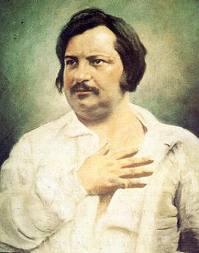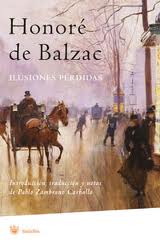Charles Dickens, Marcel Proust, Henry James, Gustav Flaubert, William Faulkner and Émile Zola - these great authors have all been inspired by the writings of one man, Honoré de Balzac.
Heralded as one of the greatest writers of the French language and the father of realism, Honoré de Balzac is renowned for his complex, morally ambiguous characters. A similar type himself, Balzac wrote over 90 novels in his life that continue to inspire writers, film makers and critics today.
Honoré de Balzac was born in Tours in May 1799. His father had managed to risse into the middle classes after a humble beginning as one of 11 children in a poor family. His mother, who came from a rich family, was married to his father, 31 years her elder, in a business arrangement and although it was a fairly loveless marriage they produced 5 children, of which Honoré was the eldest.

Immediately after his birth, Balzac was sent to a wet nurse (a common practice amongst the middle and upper classes of the age) and stayed there for 4 years.
On his return to the family home, Balzac was kept a stony distance by his parents which effected the young Balzac significantly. In 1835 he would publish a novel called Le Lys dans la Vallée which featured a callous governess named Miss Caroline, modeled after his own experiences.
Balzac was send to grammar school in Vendôme at the age of 8 where he stayed for 7 years.
In order to teach him the qualities of prudence and hard work Balzac's father deliberately gave him little money to spend which drew the wrong sort of attention from Balzac's wealthier class mates. He had a problem with discipline and authority so Balzac was often sent to the "alcove", a punishment cell reserved for disobedient students.
Balzac used his experiences at school in La Comédie Humaine (his masterpiece) and specifically his 1832 novel Louis Lambert.
Despite not suffering any apparent psychological damage from his time in the "alcove" Balzac eventually had to be sent home by the headmaster because he was in "a sort of coma". Balzac referred to it later in life as "intellectual congestion" but the time in confinement was surely a factor.
In 1814 the Balzac family moved to Paris and the 15 year old Balzac was sent to private tutors and schools for the next 2 and a half years with no real success. It was during this time that Balzac tried to commit suicide on a bridge over the Loire River.

Balzac entered the Sorbonne in 1816 and was taught, and influenced, by many great thinkers such as Victor Cousins. When he graduated he was persuaded by his father to follow him into the proffession of law but after 3 years of working as a clerk, or "a machine" as he called it, Balzac had had enough and announced his intention to be a writer.
This decision didn't sit well with Balzac's family but for the first time in his life, at the age of 20, he struck out on his own and stayed in Paris while his family moved away.
The start to Balzac's career was stuttering as he attempted first a comic opera, then abandonned it in favor of the five-act verse tragedy Cromwell. It is now considered one of his lesser works and his family certainly weren't impressed with it when he read it to them in 1820, which didn't improve relations. He followed this effort by starting, but never finishing, three novels.
The enterprising Auguste Lepoitevin came onto the scene a year later and persuaded Balzac to write short stories from which he earnt some money, though a pitiable sum.
Balzac seemed to get into some kind of rhythm after this and by 1826 he had written 8 novels, all published under pseudonyms. The books were of no great literary standard but they did their job which was to put a roof over Balzac's head and food on the table.
Lots of critics argue that however weak these first novels were, they were vital in Balzac's development as an author.
It was during the late 1820s that Balzac turned his hand to business, with little success.
Always on the look out for a good deal, he ran a publishers and a printing house but never printed anything of any use or value. He gave the businesses to a friend (who made them successful) but he was hounded by huge debts for many years.
Balzac never managed to shake of this penchant for une bonne spéculation and even up until the end of his life he became obsessed with money-making schemes such as selling Ukrainian oak in France or reprocessing the slag from Roman mines in Sardinia.

It was in 1832 (after writing several novels) that Balzac finally hit upon an idea that would ensure his literary immortality.
He decided to write an enormous series of books that would encompass all aspects of society - it was called La Comédie Humaine and it would be his life's work and greatest achievement. Les Chouans, written a few years earlier in 1829, was the first book he published under his own name and it proved to be the gateway to the promised land.
Then came El Verdugo written about a son who kills his father just as Balzac's father died, Le Peau de Chagrin and Eugénie Grandet published in 1833. The latter was his first best-selling novel and is also the most critically acclaimed of his career.
Le Père Goriot was his next big success in 1835 which claimed more than a slight autobiographical reference (Balzac fathered a a child with his married lover).
By the time the two-volume Illusions Perdues was published in 1843 Balzac had gone through a few more failed business ventures, involving magazines this time, which gave him lots of inspiration for the journalist character of Lucien de Rubempré.
Splendeurs et misères des courtisanes (1847) continued Lucien's story but by that time Balzac's health was failing.
Despite this he managed to complete to more novels Le Cousin Pons (1847) and La Cousine Bette (1848) which considering the circumstances was quite a feat.
In March 1850 in an event that has something of a fairytale about it Balzac married the woman with whom he had had a 15 year long correspondance with, Ewelina Hańska.
Their paths first crossed in February 1932 when they struck up a corespondance after Ewelina wrote to Balzac to express sadness at the portrayal of women in Le Peau de Chagrin. Ewelina was living in Kiev trapped in a marriage of convenience to a man 20 years her elder.
The pair kept up a correspondance filled with passion yet restraint until Ewelina's husband died in 1841 and they could finally meet. Balzac went to St Petersburg to see her and after financial set backs, health problems and prohibitions from the Tsar, they were finally allowed to wed in 1850.
Unfortunately their fairytale did not have a happy ending as just 5 months after his marriage, Balzac died in Paris. His funeral was attended by every writer in Paris and his image was immortalized by Auguste Rodin in a monumental statue that stands near the intersection of Boulevard Raspail and Boulevard Montparnasse.
As well as his great novels, Balzac is known for his unusual working habits.
You might call him a marathon runner rather than a sprinter in his methods of work. His preferred to eat a light meal at five or six in the afternoon, then sleep until midnight before getting up a writing until morning fueled by innumerable cups of black coffee.
It was usual for him to work for more than 15 hours at once and he once boasted about having worked for 48 hours with only 3 hours rest.